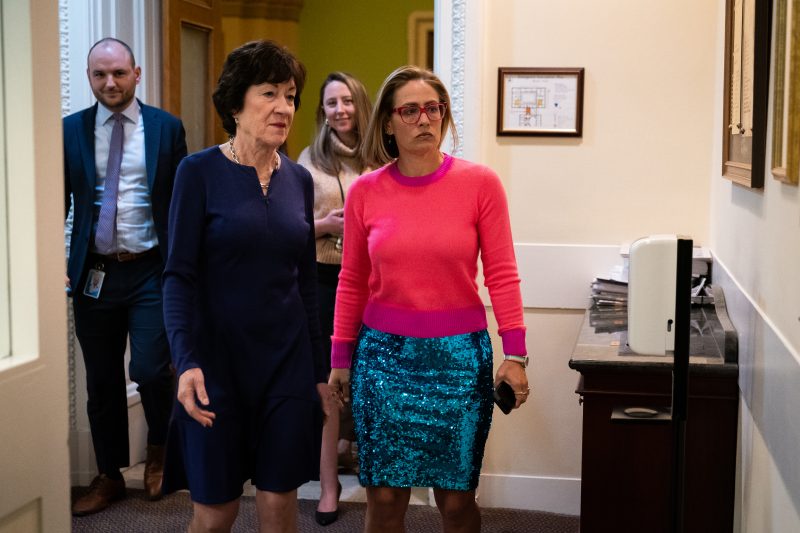Sen. Kyrsten Sinema caught many by surprise earlier this month when she announced she was leaving the Democratic Party and registering as an independent, saying in a slickly produced video that the change is “a reflection of who I’ve always been.”
But the decision was months in the making, according to current and former aides and allies close to the senator from Arizona, and it reflected Sinema’s longtime dissatisfaction with the Democratic Party. Her consternation deepened in recent years, said these people, who, like others interviewed for this article, spoke on the condition of anonymity to discuss internal deliberations.
The unhappiness has run in both directions and loomed over Sinema’s political future, prompting some critics to see a calculated ploy for survival in Sinema’s announcement. She is unpopular with Democrats back home following some high-profile party-line defections. Polls also suggested she could lose a Democratic primary if she sought reelection in 2024 — a hurdle she would no longer need to clear as an independent.
Now Sinema, 46, has caused what many see as the first big potential political earthquake in the battle for the Senate in 2024. Her shift is the latest of several reinventions throughout her career, as she has climbed the ladder from Green Party activist to state and eventually federal lawmaker with far less liberal positions. Although she has not said whether she will run for a second term, Sinema’s most recent conversion carries significant ramifications in a key battleground.
“There are certainly some who have wanted me to fit into one box or the other,” Sinema said in an interview. “But I have never wanted to do that.”
Sinema had been weighing a departure from the Democratic Party for months, people familiar with the timing said. By the fall, planning was underway, even before she appeared in late September at the University of Louisville McConnell Center, where she defended her centrist brand of politics — and further enraged some liberals — with the Republican Senate minority leader, Mitch McConnell of Kentucky, looking on.
McConnell advises Sinema frequently, according to a person familiar with their relationship, and the two spoke about her decision to defend the legislative filibuster and other matters. “She and I talk all the time,” McConnell told reporters Tuesday.
High-ranking Democrats said they remained in the dark until just before she pulled the trigger. Senate Majority Leader Charles E. Schumer (D-N.Y.) learned she would be leaving the party the day before she announced it, he said recently. White House aides have declined to say whether President Biden received a heads up, or how he reacted when he was told she would not be joining him on Air Force One for his visit to Arizona a few days before she broke the news. (Biden said at the time that Sinema needed to stay in Washington to work on legislation, calling her a “tremendous advocate” for Arizona.)
Sen. Mark Kelly (D-Ariz.) declined to say whether Sinema warned him that she was leaving the party and, like most Democrats, did not answer a question about whether he would support her if she runs for reelection as an independent. “You are getting into hypotheticals,” he said last Monday. “But I have worked very closely with her for a long period of time.”
A marathon runner and triathlete who has broken the mold of the typical senator, Sinema often eschewed Democratic events and meetings, frequently setting up her own bipartisan negotiations with Republicans and centrists on legislation. The first openly bisexual person to serve in the Senate, her latest negotiation resulted in federal legislation to protect same-sex couples that attracted 12 Republican votes in the Senate.
“She’s always been an independent thinker,” said Sen. Chris Murphy (D-Conn). “This seems like this changes the letter next to her name and not much else.”
Where some have seen a maverick streak in line with Arizona’s history of rewarding political independence, others have seen a betrayal in her disconnect from local party officials and activists who supported her election as a Democrat as she sought her Senate seat.
“There has been zero engagement since she got elected,” Stephen Slugocki, a former chair of the Maricopa County Democratic Party, said of the senator and her team. “No relationship. They haven’t been involved in anything — they’ve lost all communication. People feel disappointed that they worked hard to elect her and this is what they’ve got in return.”
For her part, Sinema has said that her decision is not political and that she has not yet made a decision about whether she will seek reelection, even as she has filed paperwork to run. She declined to pinpoint a specific moment when she decided to change her party ID.
“I’ve always been independent,” Sinema said. “I can’t point you to any specific instance because there isn’t one.”
A former social worker, Sinema entered politics not as a Democrat, but as a member of the Green Party, where she worked as a spokesperson and organized antiwar protests.
Records obtained by The Washington Post show that after losing a bid for city council, she registered as an independent voter, joining the growing ranks of Arizonans without a political home. She then pursued a seat in the state legislature as an independent affiliated with the Green Party, but lost.
By 2004, she had registered as a Democrat, won a seat in the state House and displayed a liberal streak in a legislature dominated by Republicans. Over time, she moved to the center and forged relationships across the spectrum.
“My first legislative session was a bust,” she wrote in her 2009 book, “Unite and Conquer: How to Build Coalitions That Win and Last.”
She continued, “I’d spent all my time being a crusader for justice, a patron saint for lost causes, and I’d missed out on the opportunity to form meaningful relationships.”
Republicans, she wrote, were a “discipline machine” on messaging their priorities while liberals were too “free-flowing,” to their detriment. “This is not home decorating — you do not need a flourish,” she wrote, adding, “winning is the best flourish of all.”
She adhered to that approach after clinching a toss-up seat in the U.S. House in 2012, where she was known as one of the chamber’s most moderate Democrats, and again during a bitter campaign in 2018 for an open U.S. Senate seat. Sinema rarely described herself as a Democrat. Instead, she told voters, her focus would be to “get stuff done.”
But her first few years in Washington were a disappointment to many Democrats, even though she rarely strayed from the party line. She voted to confirm William P. Barr as attorney general and David Bernhardt as interior secretary during Donald Trump’s presidency, earning her condemnation from party activists.
In an evenly-divided Senate, Sinema, along with Sen. Joe Manchin III (D-W.Va), torpedoed Democrats’ $3.5 trillion climate and social spending “Build Back Better” plan, objecting to its price tag. (She eventually supported a $1.7 trillion version, after demanding changes to a proposed tax for private equity executives that angered some liberals.)
“I don’t think she went there thinking she was going to be a traditional Washington Democrat,” said Kirk Adams, a Republican and Sinema friend and former chief of staff to Gov. Doug Ducey (R). “She told us who she was going to be.”
Sinema has largely shunned the Arizona Democratic Party and its apparatus. She routinely skipped party conventions and fundraising dinners, an approach some liberal activists hoped would change after they helped elect her to the Senate.
By early 2021, anger with Sinema among Democrats boiled over after her vote to keep an increase in the federal minimum wage out of a pandemic relief package — which she cast with a conspicuous thumbs down motion — and her continued opposition to eliminating the Senate’s legislative filibuster, which requires 60 votes for most legislation to pass.
She posted a photo of herself on social media last year drinking sangria and wearing a ring she bought from a local boutique that read “F— off.”
Fury at Sinema was reflected at the very top of the state party. Brianna Westbrook, an official with the party, tweeted that Sinema was a “villain that is opposed to democracy” last year when she opposed getting rid of the filibuster, and encouraged her staff to quit their jobs. Other party officials amplified criticism of her online.
Angry protesters confronted her at Arizona State University last year over her Build Back Better objections, following her into a bathroom while recording her on a phone. She was also confronted on a plane and at airports. Previously unguarded, she began traveling with security guards. Campaign finance records show her campaign has spent thousands of dollars for security that extends to her Phoenix home.
Former staffers and associates, many of whom spoke on the condition of anonymity to describe private conversations or offer candid assessments, said the confrontations frustrated her. One Sinema ally vented that party leadership — including the White House — could have done more to head it off.
Biden sometimes vented his frustration with Sinema’s opposition to Build Back Better. “I was able to close the deal with 99 percent of my party,” he said last year. He held up two fingers: “Two. Two people.” Asked about recent protests targeting Sinema and Manchin, which included the bathroom confrontation, he called them not appropriate but said “it happens to everybody.”
Sinema downplayed the significance of the relative silence from Democrats as she faced blowback. “I’m not sure it’s particularly relevant to me or to my thinking,” she said in the interview. “I’m perfectly capable of standing up for myself.”
Yet those close to Sinema have complained to allies that she has not gotten credit for her legislative accomplishments — including those her Democratic colleagues ran on during the midterm elections, such as the bipartisan $1.2 trillion infrastructure plan and gun control legislation that she played a key role in negotiating.
John LaBombard, Sinema’s former spokesperson, said partisan pressure was “pulling the Democratic Party and its leadership closer to the extremes in a way that was undermining her work to get bipartisan, lasting things done.”
Though Sinema is friendly with her Democratic colleagues, many of her warmest relationships in the Senate are with Republicans, such as outgoing Sen. Rob Portman (Ohio) whom she called “one of my closest friends in the world” in a recent speech, and Sen. Thom Tillis (N.C.).
During the height of the blowback Sinema received back home, Tillis wrote an op-ed defending her and comparing her to former Sen. John McCain (R-Ariz.). “While I may have fielded some angry messages from constituents a few years ago, Sinema has been on the receiving end of a full-on assault from activists across the country,” he wrote.
Allies in Arizona have long suspected that Sinema would cut ties with the Democratic Party, but even they were surprised by her timing.
“I know her pretty well, and certainly I thought she might [leave] someday, but I didn’t think she would do it now,” said John Graham, a Republican businessman.
Many Democrats said they believe Sinema saw the writing on the wall: Polls showing a low approval rating for her among Democrats, and some limited surveys suggesting Rep. Ruben Gallego (D-Ariz.), who has said he’s been preparing to run for her Senate seat, could best her in a Democratic primary.
Sinema’s decision left Democrats and Republicans scrambling to size up potential 2024 primary campaigns that could evolve into chaotic, crowded contests. Sinema, meanwhile, has filed paperwork for a 2024 bid as a politically unaffiliated candidate and has an $8 million war chest.
Some Democrats believe that if she runs for reelection as an independent, she’s effectively daring the Democratic Party to field a candidate against her and risk splitting the liberal vote, boosting a Republican candidate to victory. Such an outcome would represent a final stick in the eye to those who’ve resented her unapologetic flouting of some Democratic priorities.
“Is she willing to be the spoiler?,” asked Sacha Haworth, who briefly worked for Sinema during her 2018 Senate bid and is now advising a political action committee seeking to defeat her. “Is she the one who is going to be willing to hand the seat over to a Republican?”
Sinema’s path to victory would be a difficult one, observers said.
“Even if she’s an underdog as an independent — which I think she probably is — she looks at it as, ‘Well, if I fail, I’m supposed to fail as an independent and at least I tried,’” theorized Democratic consultant Adam Kinsey, who did not claim any insight into her thinking. “‘But if I succeed and actually get elected as an independent United States senator from Arizona, I will have blazed a trail for every elected official who wants to run outside of the two-party system in Arizona.”
He added: “She would be on the Mount Rushmore of Arizona politicos if that happened. Will it happen? Probably not.”
Matt Viser contributed to this report.



























